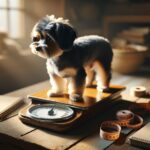The Best Fluffy Pancakes recipe you will fall in love with. Full of tips and tricks to help you make the best pancakes.

Discover the ultimate puppy feeding guide—
Puppies need 20–25 kcal per 100 g body weight daily as neonates, 4–5 meals per day during weaning, and 2–3 meals per day as juveniles, with adjustments This simple rule of thumb answers the most common feeding queries and provides the foundation for healthy growth.
Balanced nutrition during growth, as outlined by AAFCO and NRC guidelines, prevents obesity, orthopedic disease, and metabolic disorders. Feeding must adapt to both life stage and breed size.
Feeding
| Life Stage | Age Range | Key Nutrients | Feeding Frequency | Target Values | Goal |
|---|---|---|---|---|---|
| Neonates | 0–3 weeks | Colostrum, milk replacer | Every 2–3 hrs | 20–25 kcal/100 g BW/day | Immunity transfer, steady weight gain |
| Weaning & Early Growth | 3–8 weeks | Protein 22–28% DM, Calcium 1–1.5% DM, DHA | 4–5 meals/day | Gradual transition to solids | Digestive adaptation |
| Juvenile | 2–12 months | Protein 22–30%, Ca:P 1.2–1.4:1, Omega‑3s (EPA/DHA), Vitamin D | 3–4 meals/day until 6 mo, then 2–3/day | Balanced growth curve | Prevent obesity & orthopedic disease |
se meals to sustain their faster metabolism, while large and giant breeds require careful control of calorie intake and strict calcium‑to‑phosphorus balance to protect developing joints. Medium breeds fall in between, with moderate calorie density and steady growth monitoring.
Breed‑Specific Adjustments
Small Breeds
- High calorie density (metabolic rate up to 2× large breeds)
- Risk: hypoglycemia if underfed
- Benefit from energy‑rich dry or wet puppy formulas
Medium Breeds
- Moderate calorie density
- Protein 22–26% DM, calcium 1–1.2% DM
- Require steady growth monitoring
Large & Giant Breeds
- Controlled calorie intake
- Strict Ca:P balance (avoid >1.5% calcium DM)
- Risk: hip dysplasia, developmental orthopedic disease
- Should be fed large‑breed puppy formulas to limit excess calcium and energy
Monitoring & Adjustments
Growth should be tracked with weekly weigh‑ins and a Body Condition Score (BCS) chart, where the ideal range is 4–5/9. Ribs should be palpable without excess fat, and the waistline visible from above. If weight gain is too rapid or too slow, adjust portions by ±10%.
Transition to adult food varies:
- Small breeds: around 9–12 months
- Large & giant breeds: 18–24 months, depending on skeletal maturity
Key Takeaway
A structured feeding plan—tailored to life stage and breed size, with attention to protein, calcium, calorie density, micronutrients, and feeding frequency—ensures healthy growth, supports joint development, and reduces long‑term nutrition risks. Always consult a veterinarian for individualized adjustments.
Key Takeaways
- Feed colostrum and frequent milk feeds immediately after birth; if dam can’t nurse, use species-appropriate warmed replacer.
- Adjust calories
- Use puppy-formula diets with appropriate protein, controlled energy density, and breed-specific calcium/phosphorus ratios.
- Split daily calories into multiple small meals, track weight and body condition weekly, and recalibrate portions every 2–4 weeks.
- Transition to solids gradually, monitor stool, hydration, and orthopedic signs, and consult a veterinarian for deviations.
Nutritional Needs From Neonate to Weaning
 Feeding Strategies During the Growth Phase
Feeding Strategies During the Growth Phase
As your puppy progresses through the growth phase, you’ll need to adjust calorie intake quirements—large-breed pups need controlled calcium and energy to prevent excessive growth, while small breeds require higher calorie density per kilogram. Use age- and breed-appropriate feeding plans informed
Calorie Requirements
Why does calorie intake vary so much between a 6-week-old toy-breed and a 6-month-old giant-breed puppy? You need to match energy to growth velocity, metabolic rate, and body composition; toy breeds have higher metabolisms per kilogram and shorter growth periods, while giant breeds grow longer and require controlled calorie intake to prevent excessive skeletal stress. Use evidence-based energy targets adjusted by weekly weight checks and body condition scoring. During handling and feeding, prioritize gentle handling and monitor dental development, since teething affects intake and food texture tolerance. Calculate daily kilocalories using breed-size growth formulas, split into multiple meals, and reassess every 2–4 weeks. Collaborate with your veterinarian to tailor calories as growth curves and activity change.
Breed-Specific Nutrient Needs
When should you change nutrient targets to match breed-specific growth patterns? You’ll adjust targets when growth rate, body condition, or orthopedic risk diverge from breed-specific charts. Use evidence-based parameters to tailor nutrient density to expected adult size and growth velocity.
- Assess breed-specific growth curves and adjust caloric intake accordingly.
- Increase or limit calcium/phosphorus for large-breed puppies to reduce orthopedic risk.
- Modify protein quality and amino acid balance for working or toy breeds with different metabolic demands.
- Monitor body condition score weekly and recalibrate nutrient density if weight deviates from targets.
- Coordinate with your veterinarian to apply breed-specific guidelines and emerging research.
You belong to a community prioritizing precise, clinical care for healthier developmental outcomes.
Adjusting Diets for Small, Medium, and Large Breeds
You’ll adjust calories based on breed size because small breeds require higher kcal/kg and large breeds need controlled energy to prevent rapid growth.
You’ll also account for differing growth rates—small dogs mature faster while large breeds have prolonged growth periods that affect nutrient timing.
You’ll prioritize joint and bone support in large and giant breeds with regulated calcium/phosphorus and controlled energy density to reduce orthopedic risk.
Calorie Needs
How much energy a puppy needs varies systematically with adult size and growth rate, so you should match calorie intake to breed-size categories rather than feeding all puppies the same amount. You’ll avoid calorie myths h. Use feeding frequency as a tool to distribute calories and support digestion; small breeds often need more frequent meals, large breeds fewer, larger meals to prevent overeating. Monitor body condition and adjust.
- Small breeds: higher kcal/kg, 3–4 meals/day, dense nutrient needs.
- Medium breeds: moderate kcal/kg, 2–3 meals/day, steady growth.
- Large breeds: lower kcal/kg, 2 meals/day, controlled energy.
- Monitor BCS weekly.
- Consult your veterinarian for targets.
Growth Rate Differences
Why does growth pace matter for feeding? You’ll use growth charts to monitor breed-specific velocity and identify growth spurts that demand dietary adjustments. You’ll match caloric density and feed frequency to small, medium, and large breed trajectories so tissue accretion stays appropriate and metabolic stress is minimized. Track weight and condition weekly; adjust portions
| Breed size | Feeding focus |
|---|---|
| Small | Higher kcal/kg, more frequent meals |
| Medium | Moderate kcal/kg, regular monitoring |
| Large | Controlled kcal/kg, slower gain targets |
| Giant | Strict rate limits, careful monitoring |
You’ll collaborate with your veterinary team and use objective data to revise plans, ensuring your puppy develops within expected ranges and you feel supported.
Joint and Bone Support
When should you change nutrient targets to protect developing joints? You should adjust diets when breed-specific growth velocity and skeletal maturity diverge, because controlled growth supports optimal joint development and maintains calcium balance. For small breeds, moderate energy and standard calcium; for large breeds, slower growth, lower calorie density, and restricted calcium to reduce developmental orthopedic disease risk. Monitor body condition and growth charts; coordinate with your vet.
- Assess breed growth curve and adjust calorie targets proactively.
- Optimize protein for lean mass while avoiding excess energy.
- Regulate dietary calcium and phosphorus ratios for calcium balance.
- Include omega-3 fatty acids and controlled weight to support cartilage.
- Reassess at vaccine and wellness visits; tailor transition timing to maturity.
Managing Growth Rate and Joint Health in Giant Breeds
Because giant-breed puppies grow rapidly, you must manage their caloric intake, protein, calcium-phosphorus balance, and rate of weight gain to reduce risk of developmental orthopedic disease and joint degeneration.
Giant-breed puppies grow fast; control calories, protein, calcium-phosphorus balance, and steady weight gain to protect developing joints.
Monitor growth spurts closely; abrupt increases in weight and length can overload developing physes and contribute to conditions that compromise hip health.
Schedule regular weigh-ins and compare against breed-specific growth curves, adjusting portion sizes to maintain steady, moderate gains rather than accelerated growth.
Implement controlled exercise—short, frequent walks, low-impact play, and avoidance of repetitive high-impact activity—so mechanical stress on joints is appropriate for bone maturation.
Coordinate with your veterinarian for periodic orthopedic exams and radiographic screening when indicated.
Use evidence-based supplementation only under veterinary guidance; excess calcium or calories can worsen outcomes.
As a caregiver within a community of owners, share monitoring strategies and clinical findings so you and others support optimal, reproducible growth trajectories that protect joint function and long-term mobility.
Choosing the Right Puppy Food and Reading Labels
Managing growth and nutrient balance in large breeds starts to shape what you should feed a puppy. You’ll prioritize controlled energy density and appropriate puppy protein levels to support lean tissue without accelerating growth. Develop label literacy so you can compare guaranteed analyses, ingredient order, and AAFCO statements; those elements guide evidence-based choices.
- Verify puppy protein and fat percentages on the guaranteed analysis for age-appropriate provision.
- Confirm an AAFCO feeding trial or nutrient profile statement specific to growth for the breed size.
- Check ingredient order for named animal proteins (e.g., chicken, lamb) before generic meat meals.
- Evaluate calcium and phosphorus ratios listed or provided
- Look for minimal unnecessary fillers, explicit nutrient sources, and manufacturer transparency.
You’ll join a community of caregivers using clinical criteria rather than marketing claims, ensuring your puppy’s formula aligns with growth targets and orthopedic health.
When to Switch Your Puppy to Adult Dog Food
Switching your puppy to adult dog food is more than a diet change — it’s a milestone in your dog’s development. The right timing, method, and monitoring can prevent digestive issues, support healthy growth, and set the foundation for a strong adult life.
Best Age to Switch Puppy to Adult Dog Food
The right age depends on breed size and skeletal maturity:
- Small breeds: mature between 9–12 months
- Medium breeds: typically mature around 12 months
- Large and giant breeds: may need 12–24 months
Confirm with your veterinarian and use growth charts to ensure growth plates have closed before reducing calorie density.
Step‑by‑Step Transition Plan (Without Digestive Upset)
Follow this gradual method to avoid stomach issues:
- Days 1–2: 75% puppy food + 25% adult food
- Days 3–4: 50% puppy food + 50% adult food
- Days 5–6: 25% puppy food + 75% adult food
- Day 7+: 100% adult food
Always check the label for:
- Life‑stage designation
- Nutrient profiles
- AAFCO statement confirming adult maintenance standards
Monitoring Body Condition and Weight
- Use the 9‑point Body Condition Score (BCS) weekly
- Target range: 4–5/9
- Record weight trends and adjust portions if your dog moves outside the target range
Work With Your Vet and Care Team
Your veterinarian and pet care team are essential partners. Shared monitoring ensures evidence‑based feeding decisions that protect your dog’s long‑term health.
Puppy Feeding & Transition FAQs
When should I switch my puppy to adult food?
| Breed Size | Recommended Transition Age | Notes |
|---|---|---|
| Small breeds | 9–12 months | Faster growth milestones → earlier switch |
| Medium breeds | ~12 months | Standard growth rate |
| Large/Giant breeds | 12–24 months | Slower growth milestones → later switch, calorie control needed |
Decision-support flow:
- If small breed → switch at 9–12 months
- If medium breed → switch at 12 months
- If large breed → wait 12–24 months and monitor calories
How do I safely transition my puppy’s diet?
Follow a pet feeding transition plan: over 7–10 days, replace puppy food with adult food in 25% increments every 2–3 days.
Decision-support flow:
- If digestive upset occurs → slow down transition
- If puppy adapts well → continue gradual increments
What is the ideal Body Condition Score (BCS) for adult dogs?
A BCS of 4–5 out of 9 is considered optimal.
Decision-support flow:
- If BCS < 4 → increase portions
- If BCS > 5 → reduce portions
Why is the AAFCO statement important on dog food labels?
The AAFCO certification guarantees nutritional standards for adult maintenance, supporting long-term canine nutrition.
What happens if I switch too early?
Premature switching can cause nutrient deficiencies, poor growth, or excess weight gain, especially in large breeds.
Decision-support flow:
- If puppy is under recommended age → delay transition
- If large breed puppy → extra caution
Do large breed puppies need special feeding guidelines?
Large breed puppies often require 12–24 months before switching and careful calorie control to avoid joint stress.
Decision-support flow:
- If large breed puppy → follow tailored feeding schedule
- If rapid growth → consult vet for calorie adjustments
What’s the best way to monitor my dog’s weight during transition?
Use the 9‑point BCS scale weekly.
Decision-support flow:
- If BCS outside 4–5/9 → adjust portions
- If BCS stable → maintain feeding schedule
Puppy Health & Nutrition FAQs
How often should I schedule vet check-ups during puppyhood?
Plan visits every 3–4 weeks until 16 weeks, then at six months, and annually.
Can I mix homemade meals with commercial puppy food?
Yes, but balance is critical. Consult your vet or a veterinary nutritionist to maintain a balanced canine diet.
Decision-support flow:
- If homemade meals added → consult vet/nutritionist
- If weight or stool changes → adjust portions
Are supplements like glucosamine necessary for all puppies?
Not always. The need for glucosamine depends on breed, size, and joint health.
Decision-support flow:
- If breed predisposed to joint issues → vet may recommend
- If healthy puppy → supplementation not needed
How does spaying/neutering affect feeding needs?
Spaying/neutering lowers metabolism and increases fat storage. Adjust calories and monitor body condition closely.
Decision-support flow:
- If dog is neutered → reduce calories, monitor BCS
- If dog remains intact → maintain current feeding schedule
What signs indicate a food allergy versus intolerance?
| Condition | Causes / Symptoms | Decision-support flow |
|---|---|---|
| Food allergy | Itchy skin, hives, swelling, vomiting, diarrhea | If symptoms appear → consult vet immediately |
| Food intolerance | Chronic digestive upset, gas | If mild symptoms → adjust diet, monitor |
Takeaway
Transitioning from puppy to adult food is about timing, gradual change, and consistent dog health monitoring. With the right pet feeding transition plan, veterinary guidance, and attention to puppy growth milestones, you’ll help your dog thrive with a balanced canine diet into adulthood.
Conclusion
You’ll tailor feeding from neonate to adult calories, protein, and calcium-phosphorus balance to life stage and breed-specific growth rates. Monitor weight and body condition weekly, adjust energy density and meal frequency, and favor evidence-based puppy formulas for orthopedic risk reduction. Informed choices and gradual transitions protect joints and metabolic health; like a scaffold guiding bone, your measured feeding decisions shape a sound adult dog—follow veterinary guidance and adjust to objective data.









